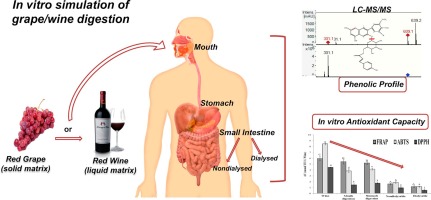Journal of Functional Foods ( IF 3.8 ) Pub Date : 2018-03-23 , DOI: 10.1016/j.jff.2018.02.034 Mariana S. Lingua , Daniel A. Wunderlin , María V. Baroni

|
The aim of this study was to evaluate the effect of the simulated gastro-intestinal (GI) digestion on the phenolic profile and the antioxidant capacity (AC) of grapes and red wines. Mouth and stomach digestion increased the bioaccesibility of TP (total polyphenols) in grapes, while in wine these compounds were already bioaccessible. Intestinal digestion reduced the bioaccessible polyphenols of grapes and wines, mainly due to the alkaline pH of the digestive fluid. Only 16% and 52% of the initial TP in grapes and wine, respectively, were found after assay (dialysed plus nondialysed fractions). Moreover, 21% and 39% of grape and wine AC, respectively, was conserved. In spite of the significant loss of polyphenols during digestion, both grapes and red wine still retain AC. Anthocyanins were less affected by human GI tract. Therefore, they could be the most relevant compounds to explain the AC of both grapes and red wine after GI.
中文翻译:

模拟消化对红葡萄及其相应葡萄酒中酚类成分的影响
这项研究的目的是评估模拟消化道(GI)消化对葡萄和红酒的酚类和抗氧化能力(AC)的影响。口和胃的消化增加了葡萄中TP(总多酚)的生物适应性,而在葡萄酒中,这些化合物已经可以生物利用。肠内消化减少了葡萄和葡萄酒中可生物利用的多酚,这主要是由于消化液的碱性pH值所致。测定后(透析和未透析的馏分),分别只有葡萄和葡萄酒中初始TP的16%和52%被发现。此外,分别保存了21%和39%的葡萄和葡萄酒AC。尽管消化过程中多酚的大量损失,但葡萄和红酒仍保留了AC。花色苷受人胃肠道的影响较小。所以,











































 京公网安备 11010802027423号
京公网安备 11010802027423号